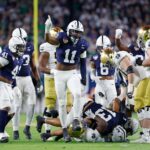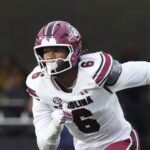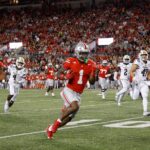[ad_1]
- Amari Cooper and Stefon Diggs are among the best remaining wideouts: The veterans’ best years may be behind them, but they can still be impact receivers in their 30s.
- The Saints could be a good fit for two of PFF’s top free agents: Cooper and Asante Samuel Jr. would help shore up units on both sides of the ball in New Orleans.
Estimated Reading Time: 3 minutes

While the biggest names in NFL free agency have already put pen to paper, a crop of talented and intriguing options remains. We’re looking at the best available free agents and identifying teams that should sign them.
WR Amari Cooper: New Orleans Saints
The veteran wide receiver finished the 2024 NFL season with a 68.7 PFF overall grade, which ranked only 61st among 133 wide receivers. However, in the previous two seasons, Cooper placed among the top 20 players at his position in PFF overall grade.
While the Saints have Chris Olave as a true No. 1 option, he had injury concerns and no other Saints wide receiver played more than 400 snaps in 2024. Meanwhile, Cooper logged 587 snaps in 2024 despite changing teams mid-season, missing two games due to injury and resting in Week 18. The move would also have Cooper play with quarterback Derek Carr once again.

WR Stefon Diggs: New England Patriots
Even though Diggs’ season was cut short by a torn ACL, as he played a career-low 430 snaps, he was still very productive. He finished the season with a 79.1 PFF overall grade, which ranked 21st among wide receivers.
Diggs has ranked in the top 25 in PFF overall grade in all 10 of his NFL seasons. While the Patriots have spent significantly in free agency, Mack Hollins is their only wide receiver addition. And none of the wide receivers currently on New England’s roster ranked among the top 50 in PFF overall grade last season, so Diggs, once healthy, would be an immediate upgrade for this unit.
CB Rasul Douglas: San Francisco 49ers
Whereas Douglas earned PFF coverage grades above 71.0 in three consecutive seasons between 2021 and 2023, his 2024 campaign did not go as planned, highlighted by a 51.6 PFF coverage grade.
However, Dougless will be only 30 years old when the 2025 season kicks off. His 86.1 PFF coverage grade between 2021 and 2023 ranked fifth among 32 qualifying cornerbacks, while his 14 interceptions in that span were the second most at the position. The 49ers lost Charvarius Ward in free agency, and while Deommodore Lenoir is expected to play in the slot, the team does not have any reliable, experienced options on the perimeter.
CB Asante Samuel Jr.: New Orleans Saints
Free agency came at the wrong time for Samuel, whose 2024 season was cut short due to an injury after a career-low 234 snaps. Even when he was on the field, he could not replicate his success in his previous two seasons. His 80.8 PFF coverage grade from 2022 to 2023 ranked 12th among 67 qualifying cornerbacks, but he earned only a 58.6 PFF coverage grade in 2024, which would have ranked 85th if he had played enough snaps.
The Saints lost Paulson Adebo in free agency, and Samuel relocating to the Big Easy would reunite him with Brandon Staley, making this a solid fit.

QB Russell Wilson: Pittsburgh Steelers
Even though he was not playing at a career-best level, Wilson bounced back following two disappointing seasons in Denver and earned a 79.8 PFF overall grade in 2024 (15th among quarterbacks) — his highest mark since 2020. Wilson’s 97.3 PFF passing grade and 56.0% adjusted completion rate on 20-plus-yard passes both led the league. His PFF overall grade was also the highest earned by a Pittsburgh quarterback since Ben Roethlisberger finished in 2017 (86.7).
There are not many – if any – better options available for the Steelers than Wilson, who generally played well for the team in 2024.











